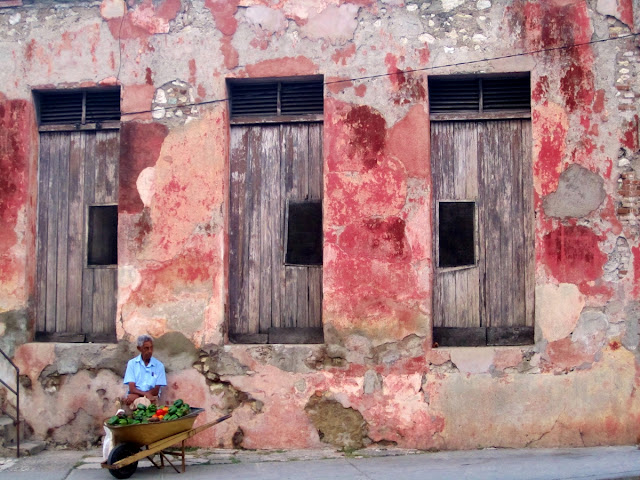We have heard stories of a hidden coastal landscape along Cuba’s southern coast, where the road is perched between rock cliffs and the crashing surf, where the ruggedness of cactus plants and nearly impassable roads blends seamlessly with lush beach-side mango orchards and the rhythms of a tranquil turquoise Caribbean Sea.
The Turquoise Tandem loaded, we depart from Santiago de Cuba, heading west towards an unknown land, on the eve of Spring’s Equinox and the rising full moon.
Day 2
The ‘Mountains to Sea’ beauty is a mixture of Big Sur, California meets the Tropics. The rugged road is tamed by our hardy Turquoise Tandem and each pedal stroke brings us more fascination with La Costa Sur. We ride for hours without a single passing car or truck. Small communities of grape growers (Cuba produces both red and white grapes for their wine), banana farmers and mango orchards speckle the hillsides and beach. We follow the contour of a small bay, climb a gravely ascent. Behind us are the dry, parched mountains and ahead, deep green fields of fruit and an endless horizon of turquoise. We spot a building perched on a hillside and Kati knows it’s the place to stay for the night. Motel Guama is the name, and we are the only guest. We head straight for the sea to snorkel and explore the reefs. When we return, the sun is setting and I write a poem:
Towering mountain summits plunge steeply towards the coastal forests of fruit
Where mango trees bask in the hot spring sun, their branches hanging heavily with ripe jewels
Offshore mangrove islands are havens for baby fish, shaded undersea mazes of roots into the sea
Coral gardens are shallow and bright, brain coral glistening in their turquoise bath, butterfly fish, blue tangs and more
Fourteen frigate birds circle in the sky, herons squawk from the mangroves and egrets search for dinner
Clouds are pink and mango orange, and this is where we sit
Day 3
The similarities with Big Sur, California are stunning. Around each turn we imagine the vistas of the Pacific Ocean, and instead of redwood trees we see towering Palmas Reals. On the road, a young man is walking his bike with a flat tire. We walk with him and he tells us we are in El Papayo, where mangoes can be harvested while riding a bike along the road. He takes us to a beachside tire repair hut where a grandfather and his grandson are harvesting from the sea grape tree in the shade of midday. They offer us fresh coconut juice and Kati plays with three year old Jose Angel (trying to catch baby pigs). They take us on a walk to their beach, miles of arching playa, white sand, rocky headlands and turquoise waves.
Day 4
We arrive at La Mula campground just five minutes before the area’s first rainfall in three months. The parched arroyos fill with water, the sea turns a strange, ominous grey and huge raindrops fall from the sky for hours. We bathe in the river. Popo, the campground chef and also an excellent fisherman, prepares us covo, conch that he has picked from the sea. He tells us stories of the many species of sharks, tiburones, he has encountered offshore from the protected reefs where he fishes. The storm clears and before we sleep, stars are shining bright overhead.
The morning is fresh and we imagine the giant ferns and endemic orchids hidden in Pico Turcino's cloud forest 6,000 feet above us are shimmering from the night's moisture and the morning's brilliant sun. |
 |
 For hours we explore the dry river bed, and follow the cobblestones from the canyon to the sea. By mid-morning we are back on our bike, encountering bridges cracked in half from raging rivers during Hurricane Dennis of 2005. We stop for lunch in a town where 200 year old mango trees provide shade for the entire community, as well as ample fruit by the warmer months of May
For hours we explore the dry river bed, and follow the cobblestones from the canyon to the sea. By mid-morning we are back on our bike, encountering bridges cracked in half from raging rivers during Hurricane Dennis of 2005. We stop for lunch in a town where 200 year old mango trees provide shade for the entire community, as well as ample fruit by the warmer months of MayAfter a long day of climbing and descending our way through this wondrous place we pass a small town where we ask for a place to buy water and food. We were pretty low on energy and the old woman that met us invited us to stay over at her house. She quickly whipped up the best meal that we had eaten in weeks and introduced us to her amazing family.

 |
 |
 We felt instantly at home and it wasn't long before all the kids in the town knew we were there and came to check us out.
We felt instantly at home and it wasn't long before all the kids in the town knew we were there and came to check us out.That evening when the husband of the family came home, we learned that he is the president of the Cooperativa of 37 farms along the southern coast. We were thrilled to meet him and he was similarly excited about us and our project. He guided us out into the fields to see all of the things that were growing.


The next morning we set out to the beach with all the kids in town and also encountered a new animal which we have yet to identify.
 |
 |
 | ||||
WE picked tamarindo at the beach and learned to make this delicious juice!
|






















































